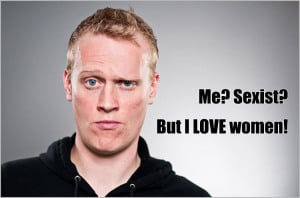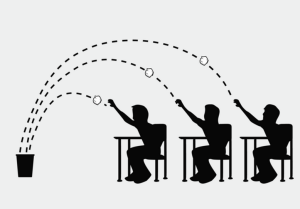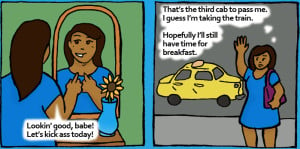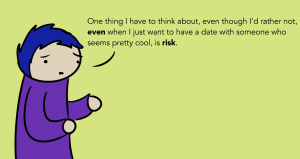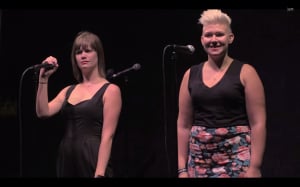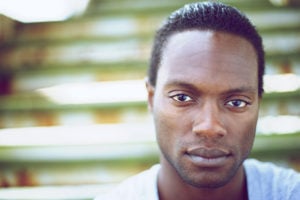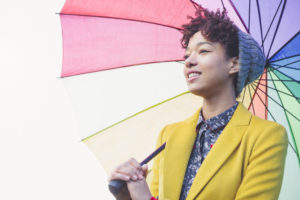
A person smiling as they stand beneath a rainbow umbrella.
Dear Person Deciding Whether or Not to Add the I,
After Spike Lee’s latest film Chi-Raq premiered, Chicagoans like myself witnessed why intentions aren’t indicative of outcomes. By attempting to help “save Chicago,” the film relied on racist tropes such as the myth that Black folks kill each other more than other races, instead of focusing on crime’s actual ingredients like structural racism, inequality, and poverty.
The film’s suggestion that Black women should withhold sex from men until they put down their guns was ignorant, sexist, and misguided.
Instead of highlighting the organizing against the school-to-prison pipeline, criminalization of black and brown folks, and police brutality led by young Black, especially queer Black and trans women, Spike ended up supporting the narrative the Right uses to increase criminalization — the opposite of his stated intentions.
Sometimes when trying our best to do the right thing, we might cause more harm.
Yet, when pondering whether or not to add the I to the ever-expanding LGBTQA+ acronym, there unfortunately isn’t a clear-cut answer.
Earlier this week, someone who started a GSA at their high school reached out to me on Twitter. They told me, “There was a person on Tumblr who is intersex who was saying it’s bad if we (LGBTQ) people include y’all in our community, is this true? I always thought the I was included?”
Their question illuminates the debate embedded in the act of adding the I.
Proponents of the move point to increased visibility, funding, and larger support for the intersex justice movement. But others point out that conflating intersex — a biological phenomenon — with LGBTQ may have unintended consequences due to existing in a queerantagonistic culture.
It’s possible that, like Spike Lee’s film, this move could end up accomplishing the opposite of our goals.
The following is a list of considerations highlighting the pros and cons that I — a non-binary queer intersex person — find myself contemplating each time I’m asked about this question.
1. Intersex Isn’t a Sexual Orientation
Being born intersex is a biological reality for up to 1.7% of the population.
Intersex genetic variations – expressed usually in a person’s sex traits, like their chromosomes, reproductive organs, or anatomy – prevent intersex people like myself from being easily categorized as either entirely male or female.
As a result, many intersex people experience what surgeons euphemistically refer to as “cosmetic genital surgeries” to “normalize” the appearance of our genitalia.
Not all intersex people have genitalia that is obviously intersex at birth. Yet, when it does happen, it’s important to note that it’s not a guarantee that the person will grow up to identify on the queer spectrum.
In fact, many often grow up to identify as heterosexual adults with no qualms about the sex or gender they were assigned with at birth.
As such, I’m unsure whether or not it makes sense to add intersex, a biological sex variation, to the LGBTQ+ acronym.
Intersex is our sex, the ship we steer throughout our existence, not a sexual identity.
It’s an embodied experience that’s already extremely difficult for non-intersex folks to understand. Adding the I could possibly make it more difficult to understand if folks begin assuming intersex is just another sexual orientation or identity.
2. Queer and Intersex People Don’t Experience the Same Discrimination
Proponents of adding the I often point to queer and intersex people’s shared history of pathologization and exploitation by the medical industrial complex.
While this is true, it’s also true that intersex people have been treated by the medical community in vastly different ways. For example, intersex babies experience clitorectomies in this country, and abroad, every single day.
These clitorectomies, and other unnecessary genital surgeries, often take away people’s ability to reproduce, create hormones, and experience sexual pleasure.
And we’re not alone.
Almost every marginalized group – especially people of color, disabled folks, people with mental illness, and conjoined twins – have had similar violating experiences.
And yet, no one is pushing for these identities to be added to the LGBTQ+ acronym. It’s widely understood that these are unique experiences that deserve their own individual attention.
3. The I May (Or May Not) Help with Increasing Representation
Thanks to the combination of intense stigma and shame, intersex people are often left feeling extremely isolated. As one intersex person recently said to me, “we’re unable to see reflections of ourselves anywhere in society.”
In contrast, conversation around LGBTQA+ identities has evolved into becoming a daily part of our national discourse.
Due to our experience of being hyper-pathologized by the medical industrial complex, our shame and isolation is not on par, I don’t believe, with most LGBTQA+ folks who aren’t intersex.
It’s true that adding the I to the well-established LGBTQA+ acronym definitely helps spread the message that we’re out here and that we exist.
Yet, is increased representation worth it if we have to camouflage parts of our identities and selves in order to fit into an established identity politic?
With representation, it’s important to ask who is being represented, who isn’t, and why.
For much of history, the face of the queer movement has often been white, cis, Christian, able-bodied, and heteronormative.
In 2001, Sylvia Rivera, “a tireless advocate for all those who have been marginalized as the ‘gay rights’ movement…mainstreamed,” argued that, “Transvestites are the most oppressed people in the homosexual community… The only reason they [the mainstream gay rights movement] tolerated the transgender community in some of these movements was because we were gung-ho, we were front liners… We had nothing to lose. You all had rights. We had nothing to lose.”
What ripple effects will radiate from merging our movement with a mainstream gay rights movement that has a history of invisibilizing the work and identities of its most marginalized members?
4. Adding the I Creates New Funding Opportunities for Intersex Groups
At this year’s Creating Change conference, Reina Gossett and Charlene Carruthers challenged organizers and participants to understand that the conference was hypocritical and unsafe for LGBTQ+ people of color because it invited a pink-washing Zionist group and Immigration Control Enforcement (ICE).
They called out the movement’s belief in, and reliance on, a criminal justice system that criminalizes, locks up, and kills LGBTQ+ Black people every day.
Instead of making institutions like ICE and occupations like the one in Palestine more “gay friendly,” they argued, we instead need to be fighting for queer liberation that doesn’t involve the police, military, or prison industrial complex.
Because of this, I have doubts about whether or not the mainstream LGBTQ movement would be a safe space for all Black and Brown intersex folks.
Are funding dollars worth forgoing safety?
For the majority of our movement’s history, we’ve had virtually no funding.
Since the I has been added more often lately, intersex activists and organizations all over the globe have seen new funding avenues open up.
I’m super grateful for this new source of funding that helps pay for the work that many intersex activists around the world have been doing pro-bono for far too long. But I wonder why we aren’t fundable alone as a movement?
I’ve always believed that the intersex movement should garner support from all types of people interested in funding human rights activism.
I’m not saying we should isolate ourselves and not work with others to achieve our goals of bodily autonomy and intersex justice.
But doesn’t it make sense to consider linking with other movements that have more similar experiences, and thus more to offer us – like the reproductive justice and disability rights movements?
Yet, people have to eat. And the reality is that funding hasn’t come without attaching ourselves to the LGBTQA+ umbrella acronym.
On the other hand, I don’t believe that non-profits and the traditional funding structure they utilize, which pools large sums of money and then distributes it in a competitive fashion, is a sustainable path forward in helping us reach our goals.
As Paul Kivel points out, there is a conflict of interest built into a non-profit industrial complex that has salaries paid out based on the inequalities it purportedly seeks to erase.
This catch-22 makes me skeptical about whether our movement will ultimately attain bodily autonomy and justice for intersex people via the non-profit industrial complex.
5. Adding the I May Distract from Our Message That Intersex Is a Human Rights Issue
Recently, we’ve also seen more funding and awareness arise as a result of strategically reframing our movement as human rights struggle.
At the end of last year, the UN’s ’s high commissioner for human rights, Zeid Ra’ad Al Hussein, met with a group of intersex activists and formally stated that intersex people are experiencing human rights violations with genital normalizing practices often disguised as “medical treatment.”
This shift towards framing our movement in this context is smart – and it’s already paying off. The positive impact can be seen in the recent passage of a law in Malta that prevents doctors and from performing genital normalizing surgeries on intersex babies.
But if we add the I to the LGBTQA+ acronym, will our specific demands get lost amidst the demands of the larger LGBTQA+ movement?
How much can one umbrella really cover, before failing to prevent some rain from falling upon those huddled underneath?
Being one of the last kids to the move onto the LGBTQA+ block, we might (unintentionally) be left exposed to the elements a lot more than the other established letters.
7. Adding the I May Possibly be Harmful to Intersex Children Thanks to Our Queerantagonistic Culture
Adding the I to LGBTQA+ may leave out most people in the intersex community because most don’t identify as queer, and possibly make some straight intersex people feel as though they have nothing to offer the movement.
But that isn’t my biggest fear.
Living in a queerantagonistic society means we have to be strategic with the choices we make regarding queer representation in the public.
Every day, we hear examples ranging from conversion therapy to the senseless violence and murders aimed mostly at working class trans women of color.
As such, my biggest fear with adding the I to LGBTQA+ is that it may have the unintended consequence of making parents of intersex babies assume their child will grow up to identify as queer, and as such, opt for surgeries as a twisted way of cutting away the gay.
Our community already has evidence to suggest that surgeries, and pre-natal screenings for intersex traits, and subsequent abortions occur more frequently when the intersex child in question has a higher likelihood of growing up to identify as queer.
For instance, “A study examining parental decisions to have cosmetic surgery performed on genitals of girls with CAH found that a large percentage of parents ‘considered social or cultural factors such as ‘genital appearance’ or ‘sexual orientation’ to be important in making their decision.’”
There’s a need to have more conversation about whether or not implicating intersex with queerness may play into vile and queerphobic “treatment” of intersex kids.
***
This obviously is a tricky question. As we move forward as a movement, I look forward to the conversations we will hopefully have as we grapple with this question.
[do_widget id=’text-101′]
Pidgeon Pagonis a Contributing Writer for Everyday Feminism. They are an intersex activist based in Chicago, working to help create a world in which every intersex baby that’s born has the right to bodily autonomy.
Search our 3000+ articles!
Read our articles about:
Our online racial justice training
Used by hundreds of universities, non-profits, and businesses.
Click to learn more








